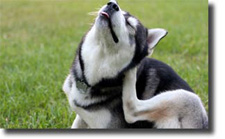Dog Lice

All You Need to Know About Dog Lice
Believe it or not, there is such a thing as dog lice. Most people associate bugs on pets as being either fleas or ticks, but rarely lice. Throughout the article we will examine what dog lice is as well as possible treatment and prevention methods for your infected pet.
Rest assured, dog lice is not the same thing as lice found on humans, especially school-aged children. You and your children are unable to get lice from your dog just as your dog is unable to get lice from your children. Furthermore, if your dog gets lice it is not able to transfer it even to your cats or kittens. So rest assured, dogs can only spread lice from one dog to another. There are a variety of reasons of why you cannot spread lice from your dog and vice versa; however, that goes beyond the scope of this article.
It is essential to note that lice found on dogs are stationary, not moving quickly like fleas or human lice. Furthermore, most dogs never get a lice infestation if they are regularly maintained, as most dogs within our country appear to be cared for highly. Even though these forms of lice can be found on dogs that are healthy, typically lice prefer malnourished living environments.
There are two different types of dog lice: one feeds on the skin while others prefer blood. As with human lice, canine lice quickly multiply and can lay up to 100 eggs at a time. However, despite their rapid ability to spread, these lice are easier to treat than fleas or ticks since they cannot live outside of the animal.
Noticing these lice is relatively easy. Simply pulling back the skin of your dog can reveal these motionless, gray parasites. They will not jump around like fleas and they are not as round and fat as ticks. Generally these lice appear more like a speck of dirt on your dog’s skin rather than a bug.
The treatment method for dog lice is relatively simple, but it is best if you let your vet recommend the best methods available. One of the most natural treatments includes bathing your dog daily for a while and allowing the natural shampoo to lather and remain on the dog for about ten minutes. Then you can apply a “lemon rinse” (combination of sliced lemon and boiling water that sets over night) with a sponge. This not only aids in remove lice but also assists with killing fleas and ticks on your dog. Then you have to remove the eggs from the strands of hair, which can prove to be difficult. Applying mayonnaise to your dog’s fur may loosen the eggs. Be sure to bathe the animal immediately afterwards allowing the removed eggs to go down the drain to prevent a repeat infestation.
Other methods of treatment include buying shampoos that have pyrethrin in them. After bathing, you may also apply a pyrethrin powder or spray to assist in the complete elimination of these pests. Frontline also has a formula that is designed for treating these lice. However, be sure to understand that the eggs may hatch so treatment may need to be repeated for up to fourteen days.
These lice are a huge pest to your family dogs causing them severe itching and annoyance. Your dog scratching constantly is one reason for you to check for lice. The dog lice can be obtained from other dogs at your grooming salon, dog day care, or even by contacting local dogs in the park. Regardless, these are the easiest parasites that infect your dog to treat since they are only found on canines and are not transferable to other family members and cats. All in all, seek your vet for recommended treatment methods for your dog if you notice a lice infestation.